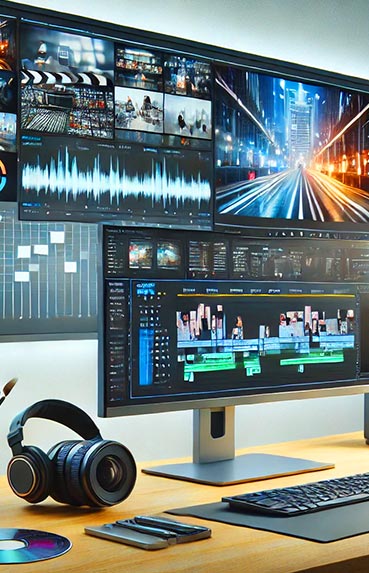Creating high-quality online videos is an increasingly sought-after skill, both for personal and professional use. The good news is that you no longer need to invest in expensive equipment to produce engaging audiovisual content; your smartphone is a powerful tool that, if used correctly, can deliver surprising results. In this guide, we will provide you with tips and techniques to maximize the potential of your smartphone and produce high-quality videos.
Smartphone Preparation
Choosing the Right Smartphone
The first step in making online videos is to have a smartphone with a good quality camera. Not all smartphones are the same in terms of recording capabilities. Look for models that offer good resolution, image stabilization, and advanced recording options such as high-definition (HD) or 4K mode.
- Camera Resolution: Opt for a smartphone with at least a 12-megapixel camera. This will ensure good image quality.
- Image Stabilization: Optical stabilization is preferable as it reduces movement and produces smoother videos.
- Recording Options: The ability to record in 4K will provide you with sharper and more detailed videos, although HD is sufficient for many projects.
Camera Settings
Before you start recording, it's crucial to adjust the camera settings to optimize video quality.
- Adjust the Resolution: Set the camera to the highest resolution your smartphone allows to achieve the best possible quality.
- Exposure Control: Manually adjust the exposure to avoid overexposed or underexposed videos.
- White Balance: Set the white balance according to lighting conditions to ensure accurate colors.
- Focus Mode: Use manual focus for greater control over which part of the image is sharp.
Recording Techniques
Video Composition
Composition is key to making visually appealing videos. Follow the rule of thirds to create balance in your shots. Imagine dividing the screen into a 3x3 grid and place important elements along these lines or at their intersections.
- Framing and Perspective: Vary your angles and distances to make the video more dynamic. Use close-ups for details and wide shots to establish context.
- Use of Negative Space: Leave space around the subject to direct the viewer's attention to it.
Lighting
Lighting is one of the most important aspects of video recording. Natural light is ideal, so shoot near windows or outdoors during the day.
- Avoid Direct Light: Direct light can create harsh shadows. Diffuse the light using curtains or shoot on cloudy days for softer light.
- Use Artificial Lights: If shooting indoors, use LED lights or studio lamps to evenly illuminate the scene.
Pro Tip: Experiment with lights of different color temperatures to add depth and ambiance to your videos.
Editing Videos on a Smartphone
Editing Apps
Editing is where your video comes to life. There are multiple video editing apps for smartphones that offer a wide range of creative tools.
- InShot: This app is easy to use and offers features like trimming, speed adjustment, and music addition.
- Adobe Premiere Rush: A more advanced tool that allows for complex edits and cross-device synchronization.
- iMovie: Available for iOS users, it's ideal for quick edits with basic transitions and effects.
Editing Techniques
Good editing can transform an ordinary video into a professional one. Consider the following aspects when editing:
- Cut and Trim: Remove unnecessary parts to maintain the viewer's attention.
- Transitions: Use simple transitions like fades to smooth the change between scenes.
- Color Correction: Adjust the color so all scenes have a consistent look.
- Add Music and Sound Effects: Incorporate background music and sound effects to enhance the video's atmosphere.
Publishing and Distribution
Publishing Platforms
The next step is to choose the right platform to publish your videos. Each platform has its own audience and features.
- YouTube: Ideal for long videos and extensive content.
- Instagram: Perfect for short and visually appealing videos.
- TikTok: Geared towards short and creative videos, especially popular among younger audiences.
SEO Optimization
Optimizing your videos for search engines is essential to increase their visibility. Here are some tips:
- Catchy Titles: Use descriptive titles that include relevant keywords.
- Description and Tags: Write detailed descriptions and use tags that enhance searchability.
- Custom Thumbnails: Design attractive thumbnails to capture viewers' attention.
Content Maintenance and Updates
Performance Analysis
Once your video is online, it's important to monitor its performance. Video platforms often offer analytics tools that can help you understand how your audience is interacting with your content.
- Views and Watch Time: See how many people have watched your video and how long they've watched it.
- Comments and Reactions: Analyze comments and reactions to get direct feedback from the audience.
Continuous Improvements
The world of online video is constantly evolving. To stay relevant, it's crucial to continuously improve your skills and techniques.
- Experiment with New Styles: Don't be afraid to try new approaches and techniques to keep your videos fresh and interesting.
- Update Old Content: Review your old videos and consider updating them with new information or improved techniques.
By following these steps and tips, you can create high-quality online videos using just your smartphone. With practice and creativity, there are no limits to what you can achieve in the world of audiovisual content.

















